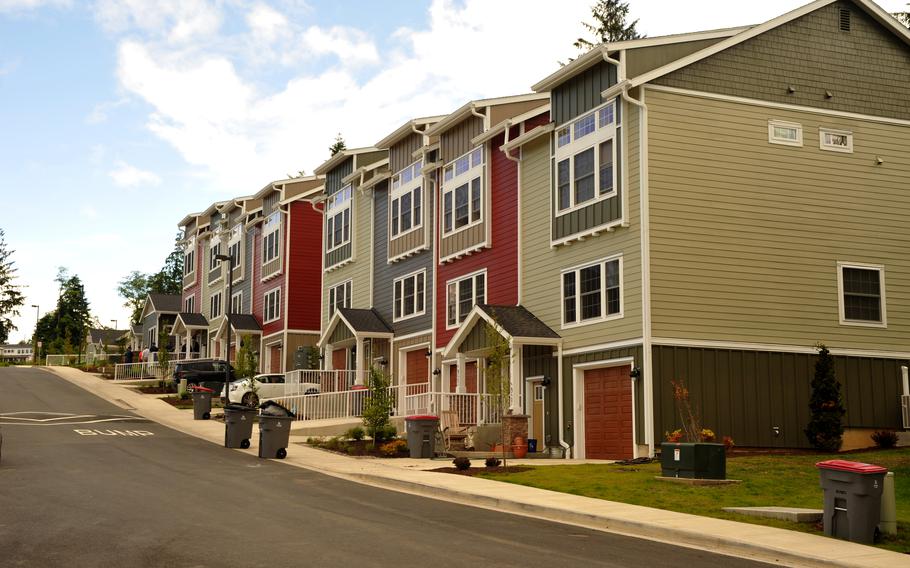
Coast Guard family housing at a complex in Astoria, Ore., in 2019. The Coast Guard can’t assess whether its members are receiving sufficient housing allowances in places that are remote or are popular vacation destinations, according to a Government Accountability Office study released Feb. 5, 2024. (Trevor Lilburn/U.S. Coast Guard)
The Coast Guard’s failure to survey housing costs since at least 2012 may be forcing service members to make tradeoffs that worsen their quality of life, a government watchdog agency found.
Coast Guard personnel and their spouses battling the rising costs and limited availability of rental properties in desirable locations say their troubles have added up to longer and more expensive commutes, less school choice and limited access to health care, according to a Government Accountability Office report released Monday.
The service’s lack of data prevents its leaders from determining whether personnel are receiving sufficient housing allowances to cover the costs of living in remote areas and popular vacation destinations, the report found.
The Defense Department’s process for setting basic allowance for housing, or BAH, influences how the Coast Guard manages housing, according to the GAO report, which reviewed data from 2018 to 2023.
It included on-site evaluations and interviews at Coast Guard stations in Kodiak, Alaska; Alameda, Calif.; and Cape Cod, Mass. The assessment began in December 2022 and ended this month.
About 41% of Coast Guard units were in remote areas, places with many vacation rentals or both, such as Kodiak or Cape Cod, researchers found.
Service members living in Kodiak had to pay high out-of-pocket costs to travel to the mainland to seek specialty health services, especially for dependents, the report said.
The fair market monthly rent for a two-bedroom apartment in Kodiak rose nearly 87% in the last 12 years, from $971 in 2012 to $1,812 in 2024, according to U.S. Department of Housing and Urban Development data.
However, fair market rents often aren’t what renters actually pay due to demand and other factors. On Tuesday, the online listing service Zillow showed just one open market, two-bedroom apartment available in the Kodiak area for about $1,800 per month. Two other listings were priced at $2,500 per month or more, excluding utilities.
Over the same 12-year period, the DOD’s monthly BAH received by an E-5 service member living in Kodiak with family rose about 23%, from $1,968 in 2012 to $2,412 in 2024, according to an online calculator. The allowance is expected to cover both rent and the cost of utilities.
About 76% of Coast Guard active-duty service members were living in private housing, researchers found.
The service also doesn’t have a clear picture of how the COVID-19 pandemic affected the costs and availability of housing, and it can’t measure the effect of negligent landlords and other housing-related problems, the GAO said.
“Some service members and spouses told us that despite the efforts of headquarters and field units to collect some housing feedback, those efforts did not directly address key housing challenges, such as private sector housing availability and cost,” the report stated.
Coast Guard officials said that the primary focus of the 2012 study “was to create a ‘baseline’ of the condition of the entire housing inventory.” They initially told the GAO that the service had no intention of conducting a new national housing survey.
But after receiving the GAO’s findings, they agreed to emulate DOD practices and conduct a new survey by the end of this year.
The Navy, Army, Marines and Air Force do regular wide-ranging surveys of their members seeking information about several housing-related issues.
Topics include satisfaction with private and government-owned housing facilities and evaluation of housing costs.
Across the military, personnel have long challenged the amounts allocated for housing and related costs.
The allowances don’t keep up with inflation or consider rent increases in locations such as San Diego or Hawaii, which have higher numbers of military personnel and vacationers, they say.
In October 2022, the Pentagon heard some of those complaints and temporarily increased off-base housing allowances in 28 regions of the country hit by rising rental costs until new rates took effect in January 2023, Stars and Stripes reported at the time.
The Coast Guard’s limited housing-related surveys didn’t go far enough, the GAO said in the report, which recommended regular in-depth analysis.
The GAO’s recommendations included having the service seek the capability to buy existing homes, as well as to acquire longer-term contracts for utility services to reduce costs. The Coast Guard concurred with the GAO’s recommendations.